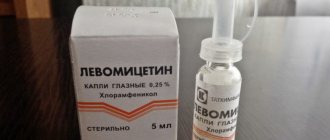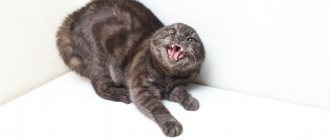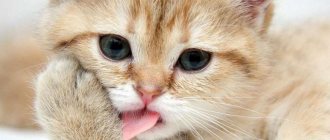Brands of drugs
Pharmacy chlorhexidine can be used to treat wounds. The drug is intended for people, but is also suitable for animals. Rarely causes unwanted reactions. Apply externally, locally.
The “Diamond Eyes” product has been developed especially for cats to treat the visual organs. Chlorhexidine in this drug is the main component. Contains vitamin C and taurine.
Shampoos with chlorhexidine for cats:
- In Pchelodar shampoo the concentration of the active substance is 5%. Suitable for cats, dogs.
- You can use Doctor VIC. The chlorhexidine content of this pet shampoo is 4%.
- To treat cat eyes, you can use Cliny drops.
- A good product from Beaphar Petshop will help if the animal gets injured.
- Citoderm shampoo is recommended by veterinarians. He also received good reviews from owners of cats and dogs.
How to remove dry discharge in the corners of the eyes?
Eyes should be cleaned only with tampons and cotton pads. Dry discharge is removed with water, special drops (Diamond Eyes), lotions (Canina Augen Pflegelotion) and sanitary napkins (Mr.Gee, Gamma, Let's go for a walk!), which are convenient to use if something gets into the eye. The use of these products allows you to gently remove secretions without causing irritation. Medicinal and traditional antiseptics should not be used for this purpose; they should be prescribed by a veterinarian in the presence of pathological symptoms such as lacrimation, swelling of the eyelids, pus, etc.
Indications for use
Shampoos are used:
- for washing cats with wounds, injuries, scratches;
- with lichen;
- for fungal infections.
Chlorhexidine in its pure form can be used:
- for treating the ears and eyes of a pet during suppuration;
- with candidiasis;
- for the prevention of sexually transmitted pathologies (gonorrhea, chlamydia, etc.);
- for treating the oral cavity during inflammation and suppuration;
- for allergic lacrimation;
- for preventive purposes to treat the eyes of some breeds, in which, due to anatomical features, purulent lesions of the visual organs are possible;
- with conjunctivitis;
- to remove specks and small foreign objects from the eyes;
- in preparation for the treatment of infectious pathologies;
- with cervical erosion.
Such drugs have an anti-inflammatory effect, destroy pathogenic bacteria, prevent the development of infectious diseases and complications, relieve redness and relieve itching.
Prevention of purulent eye inflammation in cats
It is necessary to regularly examine the cat's eyes for excess discharge, injuries, stuck debris, etc. Minor wounds can be treated with Chlorhexidine or furatsilin solution; in severe cases, you need to contact a veterinarian. It is necessary to undergo veterinary examinations 2 times a year, carry out antiparasitic treatment and receive vaccinations according to the schedule. To strengthen the immune system, you need to provide your pet with a balanced diet and protect it from hypothermia and stress. During the walk, you need to prevent his contacts with stray animals and climbing in the bushes.
It should be understood that eye washing cannot be carried out for prophylactic purposes. The cat will develop irritation and man-made conjunctivitis. Treatment should be carried out when excessive tearfulness occurs, and there are no additional pathological signs.
You should not wash your kitten's eyes. Its tears protect the cornea and mucous membrane of the eyelid from dust, debris, and microbes. And if your baby has other symptoms, you need to show him to a doctor. Chlamydia, cat flu, and other dangerous diseases begin with harmless tearfulness.
Conjunctivitis is a symptom of many infectious diseases. At first, inflammation of the mucous membrane is characterized by clear discharge. Then the exudate thickens, becomes mucous and even purulent.
The discharge dries out and crusts form. The veterinarian prescribes eye drops containing antibiotics and anti-inflammatory substances. But, to cleanse the conjunctival sac from crusts and exudate, it is necessary to do a preliminary rinse.
How to use shampoo
The products must be used strictly according to the instructions. Otherwise, it is possible to harm the cat. Do not wash your animal with the product too often. For kittens and pregnant or lactating cats, a reduced dosage may be necessary.
You need to wash your cat when she is calm and relaxed. It is better to do this with an assistant so that the pet does not escape or scratch the owner. It is recommended to take antiseptics with you so that if necessary, you can immediately treat wounds.
The cat is placed in a basin so that the level of liquid reaches its stomach. The water should not be too hot or cold. Otherwise, the animal will experience discomfort. Squeeze the required amount of shampoo onto your hand, lather, distribute over the cat's fur, paying special attention to the affected areas.
Proceed carefully so as not to hurt the cat. Leave for 5 minutes. Then rinse thoroughly with warm water. Wrap the cat in a warm, soft towel. Provide the animal with rest.
Step by step procedure
For clarity, let’s look at the procedure for wiping a cat’s eyes. The procedure is similar for a kitten, but you need to be extremely careful with it and it is better to resort to the help of a partner. You should prepare the necessary tools - cotton pads, the selected drug or drops, gauze or bandage, a 5-10 ml syringe.
Secure the animal with a towel or with the help of a partner. Communicate affectionately with the cattle, stroke them to calm them down. You must show persistence and firmness. The pet, of course, does not understand all the benefits of eye cleaning.
Soak gauze in the solution and drop it onto the damaged areas. Wait a little for the purulent crusts to soften and remove the discharge with a cotton pad. If the eyelashes are stuck together with purulent discharge, then move the disc from the nose to the ears so that the pet opens its eyes. Change the gauze and napkin in a timely manner as they become dirty.
After preliminary cleaning of the pus, rinse the area around the eye with a solution from a syringe. Complete the procedure by checkingly wiping the cotton pad.
IMPORTANT! In a situation where the veterinarian prescribed drops to the kitten after cleaning the pus (if necessary), the main drug should be applied after 5-10 minutes
As for the use of drops. About an hour after the procedure, you can anoint the damaged areas with tetracycline ointment. As a rule, it is prescribed in a course (up to 10 days continuously). The owner lifts the kitten's eyelid and applies a little ointment. Next, he closes the eye and massages it lightly with the tip of his finger (gently, without strong pressure!).
Eye hygiene for a kitten is a responsible and important procedure. But babies require special care and due to inexperience it is easy to harm them. To avoid injury, it is best to leave rinsing to a veterinarian.
In what cases is use prohibited?
Chlorhexidine rarely causes side effects or complications. You will have to refuse to use detergents based on it if you have an individual intolerance to the components of the drug or allergic reactions. In addition, shampoos are not suitable if the cat is very afraid of water. In such situations, bathing becomes too much stress, which is best avoided.
For a number of dermatological diseases, you also need to be careful. Consult your veterinarian first.
If for some reason the use of chlorhexidine is impossible, it is most often replaced with homeopathic preparations, Furacilin or a warm solution of boric acid.
Composition and action
The drug solution is applicable not only to humans, but is also used in veterinary medicine. Chlorhexidine effectively treats eye diseases in dogs and cats. Animals' eyes should be treated if an inflammatory process occurs with the release of pus or mucus.
Pharmacies usually sell a 0.05% solution, which can be instilled into mucous membranes without additional dilution. The liquid, colorless or with a slight yellow tint, without a characteristic odor, consists of the active substance chlorhexidine digluconate and distilled water. The optimal ratio is 1 to 2. The remedy has the following positive effect on the human visual organs:
- antiseptic;
- disinfectant;
- antibacterial.
How else is chlorhexidine used?
Antiseptics can be used in various ways.
Eye wash
The answer to the question of whether it is possible to wash the eyes of cats with chlorhexidine is positive. It is important, however, to carry out the procedure correctly. The cat should be calm and relaxed. It is better if an assistant holds the animal's head in the desired position. Be careful not to damage your visual organs. Use a fresh napkin every time. Never reuse an already used one.
Take a clean cotton pad or a fragrance-free napkin. You can purchase them at any pharmacy or hardware store. Soak in the medicine so that the disc is moistened. Liquid should drain from the edges of the disc.
Hold the tissue to the outer corner of the cat's eye. Swipe gently towards the inner corner, then in the opposite direction. Repeat 2-3 times. Squeeze so that a couple of drops penetrate under the eyelid.
The procedure is carried out several times a day. You will have to wipe your eyes 4-6 times during suppuration. If there are scratches or mechanical damage near the visual organs, 2-4 times a day is enough. Check with your veterinarian for the recommended regimen. The frequency of use depends on the individual characteristics of the animal and the diagnosis.
If the eyes are treated before administering the medicine, you need to wait 10-15 minutes. You cannot immediately drip the medication, as the components of the medications may interact, which will harm the cat.
Ear treatment
Chlorhexidine is used to detect ear mites in cats. This remedy is used to treat wounds left after bites to avoid suppuration and infection. Before starting treatment, remove all sulfur deposits with a clean damp cloth.
Take a clean cotton pad. Moisten with plenty of antiseptic. Gently wipe the outer ear. The liquid should not drain into the ear, as this can lead to the development of complications in the pet. Do not take your cat out for a walk during treatment so that she does not get a cold in her ears.
Avoid keeping your pet in a draft. If you use cotton swabs for cleaning, do not push them deep.
External damage
Chlorhexidine is often used to treat rashes on the bodies of hairless and short-haired breeds. Lightly dampen a cotton pad in antiseptic liquid and wipe the affected area. Repeat 4-6 times daily. Wounds, scratches and other mechanical damage to the skin are treated in a similar way.
You need to be especially careful if the skin around the eye is damaged.
Dilute chlorhexidine. The solution should be warm. Gently move the napkin soaked in liquid in the direction from the outer to the inner corner of the organ of vision. If the eyeball itself is damaged, do not do anything on your own. Take your injured cat to a veterinarian immediately.
What to do if your cat has pus in her eyes?
If you notice pus in your pet’s eyes, you should not panic and frantically go through antiseptic medications at your home pharmacy, but show it to the veterinarian. Often it indicates serious illness. In this case, the animal requires complex treatment, including not only the use of eye drops, but also oral administration of veterinary medications and a special diet. What products can be used to wash eyes at home?
Why do cats' eyes fester?
Purulent discharge is a symptom of diseases such as bacterial conjunctivitis, keratitis, blepharitis, calcivirosis, panleukopenia, viral leukemia, helminthic infestation, etc. and is a consequence of injury, aggressive action of pathogenic flora and parasites in the body. A sick animal also experiences symptoms such as fever, nasal discharge, sneezing, weight loss, vomiting and diarrhea, the presence of foreign matter in the feces and urine - mucus, blood, helminth eggs, etc.
Persian cat
Brachycephalic breeds (Persian, Himalayan, British, Scottish and Exotic Shorthair cats) are predisposed to excessive eye discharge. These animals have slightly flattened muzzles and narrow nasolacrimal ducts, which prevents the normal outflow of tear fluid. Delayed secretion increases the risk of developing a chronic inflammatory process and provokes the formation of pathological fluid.
How to wash your eyes?
Compositions used to remove purulent exudate from the eyes are divided into 3 categories: pharmaceutical antiseptics, special drops and folk remedies. Regardless of the reason for the appearance of pus, the selection of the drug should be carried out by a veterinarian, since this symptom indicates the advanced stage of the disease and requires complex treatment, where rinsing is one of the components of therapy.
Ready-made preparations (solution of potassium permanganate, furatsilin, Chlorhexidine, etc.)
Before using special drops and ointments, you need to clean your eyes from purulent exudate, crusts and dust using the following antiseptics:
- Furacilin. Crush and dissolve 2 tablets in a glass of warm boiled water. The product has an average antimicrobial effect.
- Boric acid powder. Stir 2 tsp. means without a slide in 0.5 glasses of water. Do not use this drug if there is bleeding.
- Potassium permanganate. Dissolve several crystals of potassium permanganate in water. A highly concentrated solution causes a burn to the mucous membranes of the eyes. Normally it should be transparent and slightly pink.
- Chlorhexidine. To prevent side effects (tearing, redness, etc.), you need to use the drug with a concentration of 0.05%. You need to fill the syringe with 4 ml of Chlorhexidine and 16 ml of saline solution (0.9%). Even a kitten's eyes can be cleaned with a weak solution of Chlorhexidine.
Folk remedies
To prevent your eyes from festering, you can wipe them with the following folk remedies:
- Black tea. The composition is prepared from large-leaf tea leaves without sugar and infused for at least 10 hours. Strong tea does not cause side effects, so even a kitten can wash its eyes with it.
- Lime tea. You need to pour 1 tsp. linden flowers 0.5 cups of boiling water and let it brew for 40–45 minutes. The plant is very allergenic, so it is used only as prescribed by a doctor and with full confidence that the pet is not allergic to pollen.
- A decoction of string, chamomile or calendula. You need to pour 2 tbsp of boiling water into a glass. l. spoons of any plant and leave until cool. These components have not only an antiseptic, but also a soothing effect on sore eyes.
How to wash a cat's eyes: algorithm of actions
It is necessary in advance, so that the cat does not see or worry, to prepare drops, antiseptic, tampons or cotton pads in another room. To prevent secondary infection, the procedure must be carried out with gloves. It is best to do this together, as the animal will struggle. To wash your cat's eyes, you need:
What should you consider when washing?
In newborns, rinsing the organs of vision with Chlorhexidine is carried out in cases where there is discharge of mucus or pus, characteristic of bacterial and purulent conjunctivitis. You can alleviate the baby’s condition by treating the eyes with warm liquid of this medication.
The peculiarity of the procedure is as follows: the medicine is heated slightly, a cotton swab/swab is moistened in it and the organs of vision are wiped according to the scheme described above. Parents should carefully ensure that the solution does not get on the conjunctiva!
The use of this medication during pregnancy, breastfeeding and childhood is allowed after prior consultation with your doctor.
This is necessary in order to eliminate the possibility of side effects and negative effects of the solution on the body. The only contraindication to the treatment of conjunctivitis with this medication is intolerance to any of the components included in its composition.
Read on the topic: What complications can occur from conjunctivitis?











